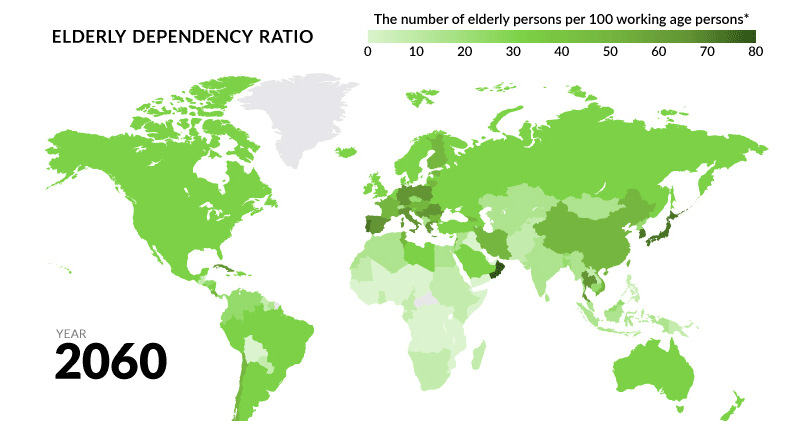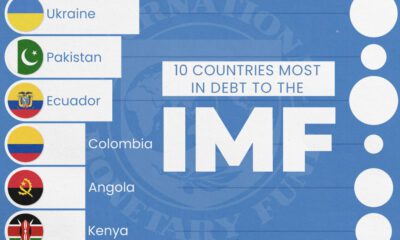Markets
Fertility Rates Keep Dropping, and it’s Going to Hit the Economy Hard
The Chart of the Week is a weekly Visual Capitalist feature on Fridays.
Total fertility rates, which can be defined as the average number of children born to a woman who survives her reproductive years (aged 15-49), have decreased globally by about half since 1960.
This has drastically shaped today’s global economy, but a continued decline could have much more severe long-term consequences. If the world has too many elderly dependents and not enough workers, the burden on economic growth will be difficult to overcome.
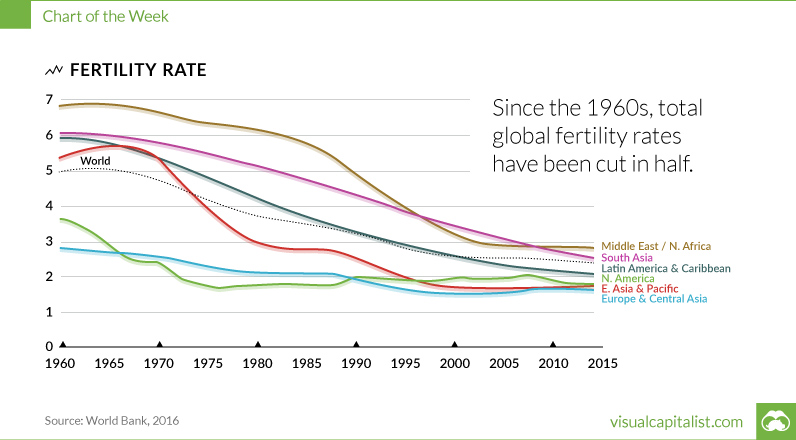
Fertility Rates Start to Decline
First, it’s important to address some of the reasons for these falling fertility rates.
In developed nations the introduction of commercially available birth control has played a large role, but this also coincided with several major societal shifts. Changing religious values, the emancipation of women and their increasing participation in the workforce, and higher costs of childcare and education have all factored into declining fertility rates.
Birthrates Wane, Economy Gains
Initially, reduced child dependency rates were actually beneficial to economic growth.
By delaying childbirth, men and women could gain an education before starting a family. This was important in a shifting labor market where smaller, family-run businesses were in decline and a more skilled and specialized labor force was in demand.
Men and women could also choose to start their careers before having families, while paying more in income taxes and enjoying the benefits of a higher disposable income. Increased spending power creates demand, which stimulates job growth – and the economy benefits in the short-term.
A Global Phenomenon
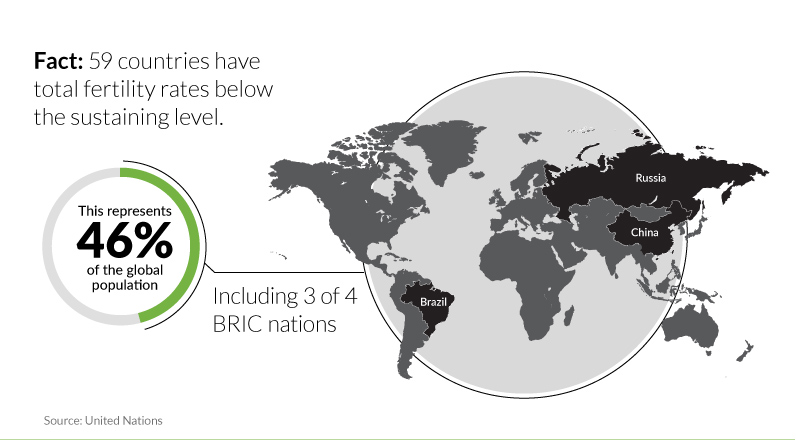
Worldwide fertility rates began to fall substantially in the mid-1960s. While each country has its own underlying causes for this, it is interesting that in developed and developing nations, the downward trend is similar.
Part of this is due to developing countries’ own efforts to rein in their rapidly expanding populations. In China, the One Child Policy was introduced in 1979, however fertility rates had already dropped significantly prior to this. India’s government was also active on this front, sterilizing an estimated 8.3 million people (mostly men) between 1975 and 1977 as a method of population control.
The Age Imbalance
So here we are now, with a global fertility rate of just 2.5 – roughly half of what it was 50 years ago.
Today, 46% of the world’s population lives in countries that are below the average global replacement rate of 2.1 children per woman.
Because these countries (59 to be exact, including BRIC nations Brazil, Russia, and China) are not repopulating quickly enough to sustain their current populations, we are beginning to see a substantial imbalance in the ratio of elderly dependents to working-age people, which will only intensify over the coming decades.
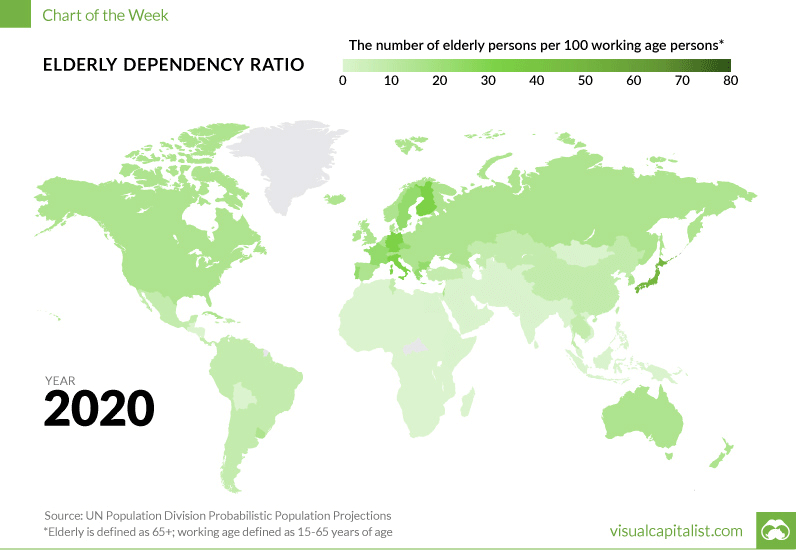
By 2100, the U.N. predicts that nearly 30% of the population will be made of people 60 years and older. Life expectancy also continues to increase steadily, which means those dependents will be living even longer. Between 2000 and 2015 the average global life expectancy at birth increased by around 5 years, reaching an average of 73.8 years for females and 69.1 years for males.
Economic Reversal
What does this mean for the economy?
As this large aging population exits the workforce, most of the positive trends that were spurred by declining fertility rates will be reversed, and economic growth will face a significant burden.
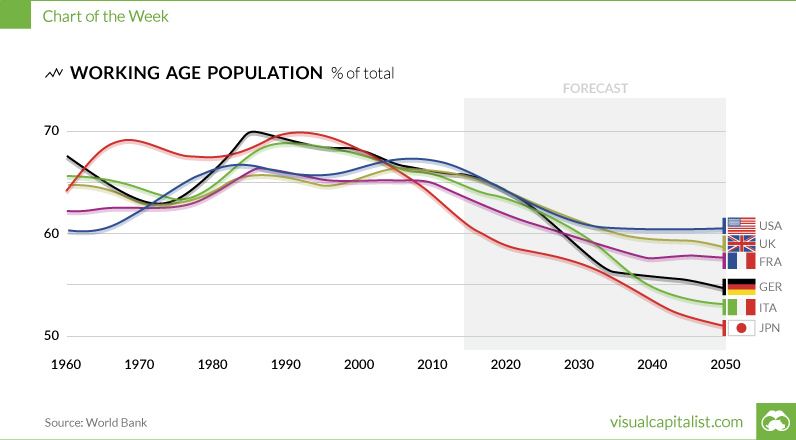
The global increase of elderly dependent populations will have serious economic consequences. Health care costs for the elderly will strain resources, while the smaller working population will struggle to produce enough income tax revenue to support these rising costs. It’s likely this will cause spending power to decrease, consumerism to decline, job production to slow – and the economy to stagnate.
Solutions
Immigration has been a source of short-term population sustenance for many nations, including the U.S. and Britain. However, aside from obvious societal tensions associated with this strategy, immigrants are often adults themselves when they relocate, meaning they too will be elderly dependents soon.
Several nations are already experiencing the effects of a large proportion of elderly dependents. Japan, with one-quarter of its total population currently over the age of 65, has been a pioneer in developing technologies, such as robotics, as a solution to ease strained health care resources. Many countries are restructuring health care programs with long-term solutions in mind, while others are attempting to lower the cost of childcare and education.
Maps
Mapped: The 10 U.S. States With the Lowest Real GDP Growth
In this graphic, we show where real GDP lagged the most across America in 2023 as high interest rates weighed on state economies.

The Top 10 U.S. States, by Lowest Real GDP Growth
This was originally posted on our Voronoi app. Download the app for free on iOS or Android and discover incredible data-driven charts from a variety of trusted sources.
While the U.S. economy defied expectations in 2023, posting 2.5% in real GDP growth, several states lagged behind.
Last year, oil-producing states led the pack in terms of real GDP growth across America, while the lowest growth was seen in states that were more sensitive to the impact of high interest rates, particularly due to slowdowns in the manufacturing and finance sectors.
This graphic shows the 10 states with the least robust real GDP growth in 2023, based on data from the Bureau of Economic Analysis.
Weakest State Economies in 2023
Below, we show the states with the slowest economic activity in inflation-adjusted terms, using chained 2017 dollars:
| Rank | State | Real GDP Growth 2023 YoY | Real GDP 2023 |
|---|---|---|---|
| 1 | Delaware | -1.2% | $74B |
| 2 | Wisconsin | +0.2% | $337B |
| 3 | New York | +0.7% | $1.8T |
| 4 | Missississippi | +0.7% | $115B |
| 5 | Georgia | +0.8% | $661B |
| 6 | Minnesota | +1.2% | $384B |
| 7 | New Hampshire | +1.2% | $91B |
| 8 | Ohio | +1.2% | $698B |
| 9 | Iowa | +1.3% | $200B |
| 10 | Illinois | +1.3% | $876B |
| U.S. | +2.5% | $22.4T |
Delaware witnessed the slowest growth in the country, with real GDP growth of -1.2% over the year as a sluggish finance and insurance sector dampened the state’s economy.
Like Delaware, the Midwestern state of Wisconsin also experienced declines across the finance and insurance sector, in addition to steep drops in the agriculture and manufacturing industries.
America’s third-biggest economy, New York, grew just 0.7% in 2023, falling far below the U.S. average. High interest rates took a toll on key sectors, with notable slowdowns in the construction and manufacturing sectors. In addition, falling home prices and a weaker job market contributed to slower economic growth.
Meanwhile, Georgia experienced the fifth-lowest real GDP growth rate. In March 2024, Rivian paused plans to build a $5 billion EV factory in Georgia, which was set to be one of the biggest economic development initiatives in the state in history.
These delays are likely to exacerbate setbacks for the state, however, both Kia and Hyundai have made significant investments in the EV industry, which could help boost Georgia’s manufacturing sector looking ahead.
-

 Personal Finance1 week ago
Personal Finance1 week agoVisualizing the Tax Burden of Every U.S. State
-

 Misc7 days ago
Misc7 days agoVisualized: Aircraft Carriers by Country
-

 Culture1 week ago
Culture1 week agoHow Popular Snack Brand Logos Have Changed
-

 Mining1 week ago
Mining1 week agoVisualizing Copper Production by Country in 2023
-

 Misc1 week ago
Misc1 week agoCharted: How Americans Feel About Federal Government Agencies
-

 Healthcare1 week ago
Healthcare1 week agoWhich Countries Have the Highest Infant Mortality Rates?
-

 Demographics1 week ago
Demographics1 week agoMapped: U.S. Immigrants by Region
-

 Maps1 week ago
Maps1 week agoMapped: Southeast Asia’s GDP Per Capita, by Country

